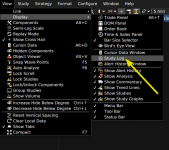I am taking the code from StochasticFull.java and using it in order to generate something I need. What I want to do is determine when the %K value for this current bar is greater than the %K of the previous bar. But I cannot seem to find the answer to this problem.
Here is the code:
var series = ctx.getDataSeries();
int kPeriod = getKPeriod();
Double K = series.stochasticK(index, kPeriod);
series.setDouble(index, Values.K, K);
int maPeriod = getKPPeriod();
int signalPeriod = getDPeriod();
if (index < kPeriod + maPeriod) return;
var method = getSettings().getMAMethod(Inputs.METHOD);
Double pk = series.ma(method, index, maPeriod, Values.K);
series.setDouble(index, Values.P_K, pk);
if (index < kPeriod + maPeriod + signalPeriod) return;
Double signal = series.ma(method, index, signalPeriod, Values.P_K);
series.setDouble(index, Values.P_D, signal);
if (!series.isBarComplete(index) || signal == null) return;
pk is apparently the array that holds the %K values. What I want to do is generate a marker when %K(this_bar) > %K(previous_bar) And %K < 25 And %D < 50.
I have this: if (pk > ????? && pk < 25 && signal < 50), but everything I have tried has failed.
Can anyone help me, please? Thank you.
Here is the code:
var series = ctx.getDataSeries();
int kPeriod = getKPeriod();
Double K = series.stochasticK(index, kPeriod);
series.setDouble(index, Values.K, K);
int maPeriod = getKPPeriod();
int signalPeriod = getDPeriod();
if (index < kPeriod + maPeriod) return;
var method = getSettings().getMAMethod(Inputs.METHOD);
Double pk = series.ma(method, index, maPeriod, Values.K);
series.setDouble(index, Values.P_K, pk);
if (index < kPeriod + maPeriod + signalPeriod) return;
Double signal = series.ma(method, index, signalPeriod, Values.P_K);
series.setDouble(index, Values.P_D, signal);
if (!series.isBarComplete(index) || signal == null) return;
pk is apparently the array that holds the %K values. What I want to do is generate a marker when %K(this_bar) > %K(previous_bar) And %K < 25 And %D < 50.
I have this: if (pk > ????? && pk < 25 && signal < 50), but everything I have tried has failed.
Can anyone help me, please? Thank you.


